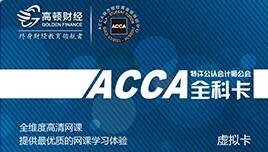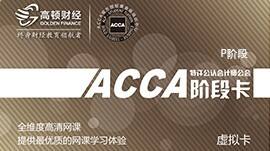2010年12月ACCA考试考官报告(F9)
General Comments
Congratulations to candidates who passed Paper F9 in December 2010!Successful candidates demonstrated their wide understanding of the F9 syllabus,since the examination paper covered many aspects of the syllabus.As in previous examination diets,some very high marks were awarded.I hope that unsuccessful candidates have learned from their experience and will be successful at their next attempt.
Specific Comments
Question One
Most candidates gained good marks in parts (a) and (c),while part (b) was rarely answered well.
Part (a) asked candidates to calculate the net present value (NPV) of Project A,allowing for inflation and taxation.
Most candidates inflated correctly selling price,selling cost and variable cost in order to find the before-tax cash flows over the four-year appraisal period required by the directors of the company.Some candidates did not defer tax liability by one year,although the question required this.Some candidates calculated correctly the tax benefit arising from capital allowances (tax-allowable depreciation),but did not provide a balancing allowance in the final year,as the directors required.The directors also required that scrap value be excluded from the evaluation.
The treatment of working capital was a problem for some candidates.Three elements of working capital can be relevant in investment appraisal,namely initial investment,incremental investment and recovery at the end of the investment project.The first two elements were needed here,with incremental investment arising from general inflation.Working capital recovery was excluded by the directors’ views on investment appraisal.Even though working capital investment was specified in the question as an initial investment,some candidates inflated the initial investment and placed it at the end of year one.
The inflated after-tax cash flows were nominal (money-terms) cash flows and the question provided a nominal weighted average after-tax cost of capital.This was the discount rate needed for Project A,although some candidates calculated another incorrect discount rate by either inflating or deflating the discount rate provided.
The calculated NPV of Project A was negative and so the investment project was not financially acceptable.
In part (b),candidates were asked to critically discuss the directors’ views on investment appraisal.These views were requirements to use either payback period or return on capital employed (ROCE),to evaluate over a four-year planning period,to ignore any scrap value or working capital recovery,and to claim a balancing allowance at the end of the four-year evaluation period.
Although part (b) asked for a critical discussion,a significant number of candidates calculated and commented on the payback period and the ROCE of Project A.This was not what the question asked for and gained no credit.Many candidates limited their discussion to payback and ROCE,and therefore lost marks because they did not discuss the four-year planning period,ignoring any scrap value or working capital recovery,and claiming a balancing allowance at the end of four years.
The directors’ views were not consistent with a theoretically sound evaluation of Project A using relevant cash flows,A critical discussion should have focused on this.
Part (c) required candidates to calculate a project-specific cost of equity for Project B,which was a diversification into a new business area,and to explain the stages of their calculation.
Answers that calculated a project-specific weighted average cost of capital (WACC) in addition to a project-specific cost of equity did not gain any additional credit,since this was not required.In fact,the WACC could not be calculated,since the question did not include a cost of debt.
Better answers ungeared the equity beta of the proxy company to give an asset beta,regeared the asset beta to give a project-specific equity beta,and then used this equity beta and the capital asset pricing model (CAPM) to calculate a project-specific cost of equity,explaining the stages of the calculation in terms of systematic risk,business risk and financial risk.
Question Two
Many students gained good marks on parts (b) and (c) of this question,while not doing very well on part (a).
In part (a) of this question,candidates were provided with financial information for a company and asked to evaluate suitable methods for it to raise $200 million,using both analysis and critical discussion.Many answers struggled to gain good marks for reasons such as poor understanding of sources of finance,a lack of analysis or errors in analysis,misunderstanding of the financial position and performance of the company,and a shortage of discussion.
The question said that the current assets of the company did not include any cash,but many answers suggested that $121 million of the $200 million needed could be provided from $121 million of retained earnings in the balance sheet.As the company had no cash,this was of course not possible and shows a misunderstanding of the nature of retained earnings.
Some answers suggested asking the bank to increase the $160 million overdraft to $360 million in order to provide the finance for the $200 million acquisition.Since the acquisition was a long-term investment,short-term finance could not be used under the matching principle.Suggestions of using lease finance were also not appropriate,although discussion of the sale and leaseback of the company’s non-current assets was relevant.Some answers discussed business angels,government grants and venture capital,but these sources of finance are not relevant to a $200 million acquisition.
Analysis of the financial information given in the question was needed to support any critical discussion of ways of raising the $200 million required.Some answers gave no analysis or very little analysis and so were quite general in nature,outlining for example the differences between equity finance and debt finance.Errors in ratio calculations were common,highlighting the need for candidates to understand accounting ratio definitions.Four years of profitability information was provided,allowing trends and growth rates to be calculated,although some answers considered only information from the first year and the last year.The information,when analysed,gave a very gloomy picture and indicated that the company would have difficulty raising the cash it needed,whether from debt finance or equity finance.Taking on more debt would cause gearing,interest cover and financial risk to rise to dangerous levels,while existing and potential shareholders would not look favourably on a company that had not paid dividends for four years,especially one whose growth in profitability was on a downward trend.
Part (b) asked candidates to briefly explain the factors that influence the interest rate charged on a new issue of bonds,i.e.traded debt.Good answers discussed such factors as the period to redemption,the risk of the issuing company,the general level of interest rates in the economy,expectations of future inflation,redemption value and so on,and easily gained full marks.Poorer answers did not show understanding of the relationship for a bond between market value,interest rate,period to redemption,redemption value and cost of debt.
Part (c) asked candidates to identify and describe the three forms of efficiency that can be found in a capital market and many answers correctly identified and described weak form efficiency,semi-strong form efficiency and strong form efficiency.Some answers incorrectly stated that capital market efficiency was about the information available in the market,when in fact capital market efficiency is concerned with pricing efficiency,i.e.the nature of the information reflected in the market prices of traded securities,something which is investigated by carrying out empirical tests.From this point of view,it is theoretically possible for a capital market to be simultaneously weak form,semi-strong form and strong form efficient.
Question Three
Many candidates gained full marks in answering part (a),picked up reasonable marks on parts (b) and (d),but in many cases gave poor answers to part (c).
Part (a) required candidates to calculate the cost of a current inventory ordering policy,and the change in inventory management costs when the economic ordering quantity (EOQ) model was used to find the optimum order size.
A number of answers failed to gain full marks because they did not calculate the change in inventory management costs,even after correctly calculating these costs under the current ordering policy and after applying the EOQ model.
Poorer answers showed a lack of understanding of the relationship between ordering costs and holding costs,and an inability to calculate these costs.
In part (b),candidates were required to describe briefly the benefits of a just-in-time (JIT) procurement policy.No credit was given for discussing the disadvantages of such a policy,as these were not required.Many answers gave a short list of benefits,rather a description of the benefits,and so were not able to gain full marks.
Part (c) asked candidates to calculate and comment on whether a proposed change in receivables management (offering an early settlement discount) was acceptable,and to calculate the maximum discount that could be offered.
Some candidates gained full marks for calculating correctly the reduction in financing cost,the cost of the discount and the net benefit of offering the discount.The reduction in financing cost and the cost of the discount were both based on credit sales for the year of $87.6 million.
Poorer answers based their calculations on current trade receivables of $18 million,even though the question stated that the early settlement discount would be offered to 25% of credit customers.Comparing current trade receivables and current credit sales showed that current receivables paid on average after 75 days,a credit period that would be reduced to 60 days through improved operational procedures.Some candidates assumed incorrectly that the current trade receivables period was 60 days and made incorrect calculations as a result.
The maximum discount that could be offered would be equal to the benefit gained from the discount,i.e.the saving in administration and operating costs added to the reduction in financing cost.
Feedback from markers indicated that some answers to this part of question 3 were disorganised,with unlabelled calculations and a lack of explanation.It is important to help the marking process by labelling calculations,explaining workings and using correct notation,e.g.‘$ per year’,'$m’,'days’ and so on.
Part (d) required candidates to discuss the factors that should be considered in formulating working capital policy on the management of trade receivables.
Poorer answers offered a list of actions that could be met in trade receivables management,such as “send out letters to trade receivables”,call customers on the telephone”,produce an aged receivables analysis regularly”.
Working capital policy on trade receivables management should consider what period of credit to offer,how to determine the amount of credit offered,when creditworthiness needs to be assessed and to what extent,and so on,and it is often informed by the trade receivables management policies of competitors.The policy should provide the framework within which the actions referred to above would be undertaken.
Question Four
Many candidates did well in parts (a)(i),(b) and (c),while doing poorly in part (a)(ii) and struggling to remain focused on the question asked in part (d).
In part (a) candidates were required to calculate the equity value of a company using the dividend growth model (DGM) and then the net asset value.
Many candidates calculated correctly the share price of the company using the DGM,although some candidates failed to multiply this share price by the number of shares to give the equity value of the company.Poorer answers re-arranged the DGM in order to calculate a cost of equity using the current share price,but this was unnecessary,as the cost of equity was given in the question.
The net asset value calculated by many candidates showed that they were uncertain as to the meaning of ‘net asset value’.Some candidates gave a net asset value of $94 million,a figure which fails to treat preference share capital as prior charge capital and hence include it with long-term liabilities.
Part (b) asked candidates to calculate the after-tax cost of debt of a company.Many candidates gained full marks by calculating the after-tax interest payment,using two discount rates to calculate two net present values for investing in the bond,and using linear interpolation to calculate the after-tax cost of debt.Answers that did not gain full marks contained errors such as using the wrong tax rate (it was 25%),addition or multiplication errors,using the before-tax interest payment,or putting incorrect values to variables in the linear interpolation calculation.
Some answers calculated the cost of capital of preference shares in addition to calculating the after-tax cost of debt,and then attempted to average the two costs of capital.While preference shares are classed as prior charge capital,they pay a dividend,not interest,and preference shares are not debt.
In part (c),candidates were required to calculate the weighted average cost of capital (WACC) of a company.Candidates therefore needed to calculate the market values of ordinary shares,preference shares and bonds,and the preference share cost of capital,having already calculated the after-tax cost of debt and being given the cost of equity by the question.
The most common reason for not gaining full marks was calculating incorrectly the cost of capital of the preference shares.This can be found by dividing the preference dividend by the market price of the preference share,but many candidates used the dividend rate of the preference shares (8% per year) as the dividend,instead of calculating the preference dividend from the nominal value (par value),i.e.8% of 50 cents giving a dividend of 4 cents per share.
Other reasons for losing marks included aggregating the market values of ordinary shares and preference shares,before applying the cost of equity to both:omitting the preference share capital from the WACC calculation;multiplying the after-tax cost of debt by (1–t) (one minus the tax rate);and calculating a new cost of equity,even though the cost of equity was given in the question.
Part (d) asked for a discussion of the factors to be considered in formulating the dividend policy of a stock exchange listed company.The requirement was worded carefully to encourage candidates to consider the dividend policy of a company faced by the demanding business environment of the real world.Little credit was therefore given to discussions of the dividend irrelevance theory of Miler and Modigliani,which is based on the assumption of a perfect capital market,since capital markets in the real world are no more than semi-strong form efficient.
While a discussion of dividend relevance theory compared to dividend irrelevance theory was not asked for,some credit was given to answers that discussed dividend relevance theory where points were made that had real world relevance.These points included the signalling effect of dividends,shareholder preference for certain dividends rather uncertain capital gains,and the importance of the clientele effect in imperfect capital markets.
Better answers focused on some of the factors covered in the suggested answer,including the need to consider liquidity,the importance of relating dividend decisions to investment and financing decisions,and the need to consider financial risk.

相关阅读
2012年12月ACCA考试P4考试考官报告2013/06/19
2012年12月ACCA考试P3考试考官报告2013/06/19
2012年12月ACCA考试P2考试考官报告2013/06/19

















